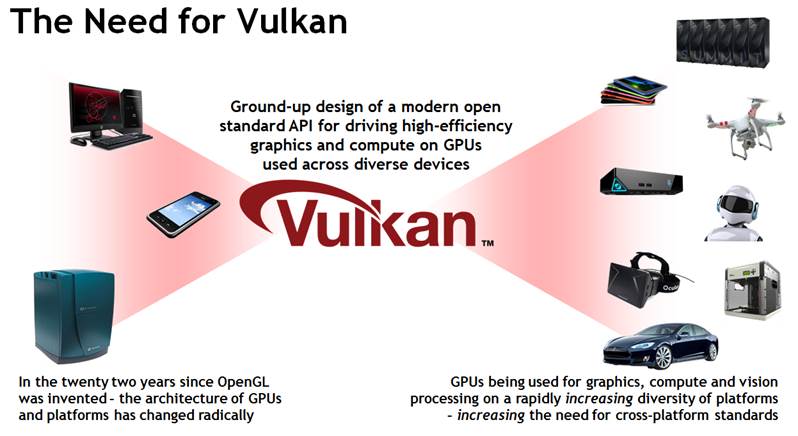Khronos Releases Vulkan 1.1, SPIR-V 1.3 Specifications

Khronos, the open consortium behind the low-level Vulkan graphics API, released Vulkan 1.1, the first major update to the specification. The company also open-sourced the SPIR-V 1.3 specification and Vulkan 1.1's full conformance tests.
Vulkan 1.1
This new update to Vulkan brings much requested features by game developers such as subgroup operations. These operations enable highly efficient sharing of data between multiple tasks that run in parallel on a GPU.
Vulkan 1.1 also enables secure playback and display of protected content (DRM). The group argued that it simply wants to make the feature available, as it’s been a much requested feature, too, but it will be up to the developers to use it. In other words, if DRM bothers you, take it up with the game developers.
The new specification also integrates many of the proven extensions made for Vulkan 1.0 since it was first released. These include simultaneous rendering of multiple image views, multi-GPU support, and cross-process API interoperability for advanced rendering and compositing operations that are often in more demanding applications, such as virtual reality.
Additionally, Vulkan 1.1 supports advanced compute with 16-bit memory access, High-Level Shader Language (HLSL) memory layouts, as well as the processing and compositing of video streams through direct sampling of YCbCr color formatted textures that are produced by many video codecs.
SPIR-V 1.3
The new SPIR-V 1.3 specification increases the capabilities of the Vulkan shader intermediate representation to support subgroup operations and enable enhanced compiler optimizations.
SPIR-V is an intermediate language for parallel compute and graphics developed by Khronos. The new specification update adds support for subgroup operations and enable enhanced compiler optimizations.
Stay On the Cutting Edge: Get the Tom's Hardware Newsletter
Get Tom's Hardware's best news and in-depth reviews, straight to your inbox.
The SPIR-V ecosystem now also contains front-end compilers for both the HLSL and the OpenGL Shading Language (GLSL), which means it should be easier to use by a wider range of developers.
David Neto, shader compiler team lead at Google and SPIR working group chair, said:
We are excited to see the progress developers have made with the SPIR-V standardized IR. Developers are using the shader language of their choice and a variety of open source compilers to ship their games and applications. The Vulkan tools and ecosystem is evolving rapidly.
To encourage more collaboration in the Vulkan ecosystem, Khronos created the aptly named Vulkan Ecosystem Forum, where developers can share issues or create new solutions together.
-
DerekA_C all that is left is the mix and match gpu utilization and MS will have a major API fight on their hands. We also need devs to stop being lazy or scared wimps of implementing Vulkan into their games. Like all UE4 games screw dx11 and dx12 they are unstable garbage on modern games anymore like a dozen games made on UE4 in the last 2 years.Reply -
TripleHeinz I was dreaming about making render passes optional in v1.1, alternatively providing a more direct and flexible render path.Reply
